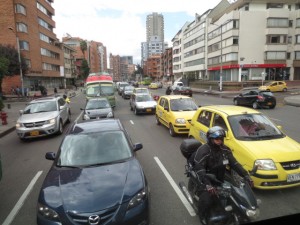Avenida Séptima (7th Avenue) is a major thoroughfare that connects the north and south through the center of the city. It is a corridor of economic and historical importance where many of the city’s most important government institutions, financial and commercial entities, universities, and a large park, Parque Nacional, can be found. When there is a protest march (relatively common here) it is often along this street. One of the most popular Ciclovía routes is on the Séptima and people come out in droves to ride, walk, run, or skate it. A cycling companion once told me that during Ciclovía the Séptima is also a corridor of social encounter, as middle class and wealthy people who live in the north and working class and poor people who live in the south, who otherwise don’t interact informally in this socio-economically divided city, have a chance to circulate on equal footing. So it is a critical transportation corridor with major symbolic significance in this city.
During the week, I travel up and down the Séptima almost everyday since my kids attend schools in the neighborhood of Chapinero, which is north of where we live. We typically mount a Transmilenio bus for these trips, sometimes a colectivo (one of the many buses that pick up and drop off passengers upon request), and every now and again a taxi. I usually don’t ride a bike on the Séptima because the traffic can be especially chaotic and unpredictable along here–one minute it is a stand-still traffic jam with motorcycles taking up spaces between cars–the next minute it is break-neck speed as the buses, private cars, and motorcycles all race to make up for lost time. All the time, colectivos and taxis unexpectedly swerve to the sides to pick up or drop off passengers.
Conditions for cyclists are extremely unfriendly: potholes and irregular asphalt, rushing traffic, doors suddenly opening, pedestrians wanting to cross in front of you, and most of all the incessant buses and colectivos threatening to cut you off.
But the cyclists are there. These cyclists have the option of riding a “protected” parallel cicloruta/cycletrack just several blocks away (on the 13th and 11th), but they choose to ride the Séptima–because it’s more direct, faster, and perhaps even because it’s more of an adrenaline rush. Some of these cyclists are deliverymen, riding cargo bikes and carrying heavy loads. Others are young twenty-something students (men and women), heading to class at one of the universities on fixies, cruisers, or mountain bikes. Still others are recreational cyclists, kitted out in their team Colombia racing jerseys. And many, if not most, are this city’s everyday cyclists who don’t draw a lot of attention to themselves–the working class men getting to and from their places of work.
I rode the Séptima this morning around 9am, just as rush-hour was winding down, with a time-lapse camera, starting at my daughter’s school on Calle 70a and ending at my apartment on Calle 26, a ride of about fifty blocks. In this section, much of the Séptima is six lanes wide, with a divider down the middle. Cyclists mostly ride in the right lane, but it’s not unusual to see riders in the left lane (what in the U.S. we might call the “fast lane;” here it is only “fast” because it is not interrupted by buses, taxis, or cars pulling over).
This 2 minute video shows my experience.
